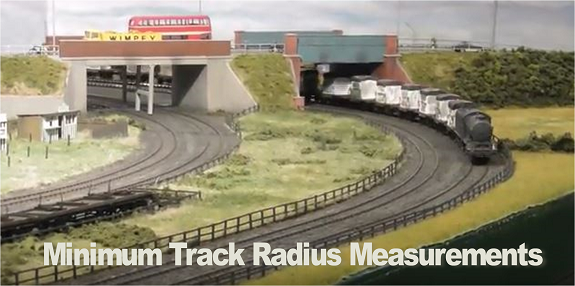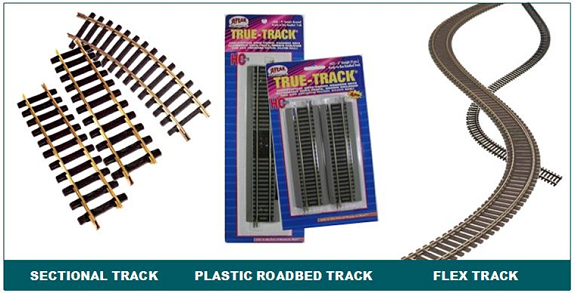Everything on model trains, model railroads, model railways, locomotives, model train layouts, scenery, wiring, DCC and more. Enjoy the world's best hobby... model railroading!
Minimum Track Radius Measurements
Online Train Club Member Allan contributed this article.
Everyone has limited space for their layout, so compromises need to be made when scaling the size of a real prototype railroad down to fit in the size of the average garage or spare room.
Real railroads need miles of space. The fact is; a real train can be around 90 to 120 cars which can stretch out for 1 to 1 1/4 miles. When the train gets moving it will travel for tens or hundreds of miles. For the engineer to stop the train quickly at 55 miles an hour, would likely require more than a mile of the track using the emergency brakes.
The big challenge for the hobbyist is to condense the track, countryside, mountains, etc into a fraction of the space without making the perspective look forced or too unnatural. In the real world, one mile equates to 5280 ft or 63360 inches which, when converted to HO scale reduces to 60ft or 728 inches. That’s still a huge space to replica just one mile of a real railroad. On N scale a mile is 33ft or 396 inches. This becomes even more problematic when straight track transitions into curved track to allow the train to change direction.
Turning Trains Takes Space
A person can stop on the spot, rotate, and continue walking in any direction they want. Road vehicles have a reasonably small turning circle in relation to their length and width, but a 90 to 120 car train (real or scale model) needs a considerable distance to change direction without derailing. This is why track radius is so important.
Prototype curves scale down to the following in HO scale:
- Mainlines – 130 inches
- Mainlines in mountains – 100 inches
- Branch lines – 70 inches
- Sidings and Yards – 50 inches
Working to those measurements will still require a big layout space. That’s where the compromise needs to come into play when replicating a real railroad to a greatly reduced scale. The larger the radii on a layout, the more life-like the layout would look, and the smoother trains will operate.
Keeping with HO scale, a radius of 48 inches or even larger would be optimal. However, this is not a perfect world, so working within a smaller space will necessitate the use of smaller radii curves.
The following benchmark would apply in HO scale:
- Preferred minimum radius – 32 inches
- Conventional radius – 24 inches
- Sharp curve radius – 18 inches
So, even with dreams of creating a perfect miniature replica of a real prototype railroad, reality kicks into play. The distance a train travels, and the radius of curves are just two of the things that will necessitate compromise. The trick is to accomplish this without abandoning the goal of achieving reasonable realism and smooth operation.

















I enjoyed reading your great article however it got me sweating when I saw “Mainlines – 130 inches” in bold type. It was not until I scrolled down that I read the more comforting “Preferred minimum radius – 32 inches”.
Could I suggest you edit the relevant paragraph to say something like “Prototype curves scale down to the following in H0” then blokes like me won’t have a pink fit.
Good suggestion – consider it done!